Items
keywords is exactly
illness
-
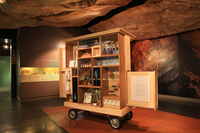
Chest: a botanical ecology
Illness and disease affect us all. The treatment of these conditions however, has been vast and varied, depending on the historical periods and the cultural context in and during which they are practiced. Situated in the rock art gallery, where healing power is expressed in San paintings, this mobile set of cabinets explores a rich complex of healing practices through the display of a medicine chest which was donated to the university of Cape Town in 1978. This chest belonged to a British dentist, who practiced in Cape Town from 1904, and who bought the chest for a hunting trip he undertook in 1913 to (then) Northern Rhodesia. The idea of the chest then gives rise to a variety of forms of healing: from instruments used to exorcise evil spirits and children's letters written to celebrate a heart transplant; to medicinal flowers bought at the Adderley Street flower market. The exhibition aims to visualise and materialise illness and its treatment from historical, cultural and disciplinary perspectives. Drawing on well-established historical and contemporary connections between the disciplines of Botany, Medicine and Pharmacology, the exhibits also suggest latent links which are at times political, at times whimsical. -
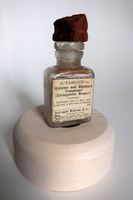
Livingstone
A small wooden chip from the same object collection as the medicine chest balanced on top of one of the bottles from the chest. "The treatment, the Livingstone rouser, was formulated by Dr Livingstone, who, after an attack of malaria in 1853, patented this mixture of quinine and purgatives (calomel, rhubarb and jalop) mixed with opium (Barrett & Giordani 2017: 1655–1666). The chip balanced on its lid is said to be from the almond tree under which he proposed to Mary Moffat in 1844. The juxtaposition of these two objects, one representing the quantifiable and the other the poetic, draws the viewer to consider the conflation of these two realms" (Liebenberg 2021: 273). -
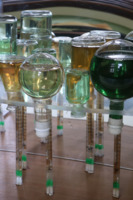
Forest
"The bottles and pipettes in 'Forest' were originally sourced from the storage rooms of the Chemistry department, where they awaited disposal. This cabinet responded to the lacuna of indigenous material represented by the chest and addressed this imbalance by filling the bottles with teas made from local medicinal plants. Staging the bottles and pipettes to simulate a forest references the prejudice of Burroughs, Wellcome and Co (BWC) against these natural remedies, ‘purifying’ them through laboratory processes before they were deemed trustworthy and marketable. This process also occluded the original source of the remedies and sowed the seeds of biopiracy. The various items of glassware in this cabinet were filled with a selection of infusions made from Balotta africana, Sutherlandia frutescens, Agathosma crenulata, Melianthus major, Mentha longifolia, Petroselinum crispum, Hypoxiz villosa and Salvia officinalis" (Liebenberg 2021: 255). -

‘Mrs Glover attending to an ill African chief.’
"The figure of ‘Mrs Glover’, kneeling and treating what appears to be a very ill man, exudes not only the authority of Western medicine within the local context but conveys her as the self-sacrificing and caring European ‘civilizer’ in service of expanding the empire, ‘the medicine chest conveniently by her side’ (Johnson 2008b: 259)" (Liebenberg 2021: 63 - 65). -

BC666
A page of the Tabloid guide. -

Wednesday, 1 April 2020
Marseille, France: A resident of a block of flats is passed food by his neighbours using a rope made of blankets. -

Simone
A year after Simone's death from cancer, Cousteau announced that he had been having an affair with a woman, Francine Triplet, for over a decade. He also had two children with her, Diane and Pierre-Yves. -

Untitled
An IV drip releases a drop on a handkerchief floating above a fan, drying it before next one falls. -

Haematite Miner's Lung (Or Sidero-silicosis)
Catalogue No: R3-d55-0331. Origin: UCT Anat Path museum. Old Museum No: V:x:6. Year: not recorded. Clinical data: No further clinical or laboratory details are available other than that the patient was an emaciated 50 year old man. Macroscopy: The specimens preserved are both lungs, the heart, kidneys, spleen and and portions of liver. In the thorax, both pleural cavities were completely obliterated by a fibrous pleurisy of long-standing and both lungs were universally adherent throughout. They were stripped off with difficulty and were found to have thickening of the pleura over the upper lobe on the left side and the upper and middle lobes on the right. The lower lobes on both sides were soft and spongy while the upper lobes were dense and firm on palpation but on section there was no cavitation and no evidence of tuberculosis. The left lung showed a dense fibrosis of the whole of the upper lobe and the upper third of the lower lobe; no crepitant lung tissue could be found in the upper lobe while the lower two-thirds of the lower was crepitant and showed emphysema of a hypertrophic nature. The lung was a dull brick colour and haematite dust flowed out with the fluid when the lung was sectioned. The right lung presented a similar appearance to the left. There was a solid dense fibrosis of the upper and middle lobes and the lower lobe showed fibrosis with hypertrophic emphysema. There was no evidence of tuberculosis and on palpation, a dense fibrosis was found with no nodular formation whatever. On section, it showed a similar appearance of a brick-dust colour, dilated bronchi and uniform fibrosis of the upper and middle lobes with no crepitant lung tissue. The pericardial sac was slightly increased in size due to a hypertrophied and dilated heart. The hypertrophy was mostly on the right side and there was a terminal dilatation of the right atrium; the valves and coronary vessels unremarkable.The liver was small and on section showed venous congestion and cloudy swelling. Microscopy: On microscopy, sections of lung show a diffuse fibrosis of both upper lobes with no recognizable lung tissue. The fibrosis in areas has a slightly whorled arrangement, the centre of which is hyaline and contains no iron pigment and surrounding it is a zone of cellular tissue containing masses of iron. In the upper part of the lower lobe where the lung tissue is recognizable as such, a few nodules definitely resembling silica nodules are to be seen. In the both lower lobes a solid oedema was noted and emphysema marked. The fibrosis was not present to anything like the same extent in the lower lobes, the emphysema being the most marked feature. No evidence of tuberculosis was found in either lung, though a calcareous gland was found in the hilum. Under polarised light, the iron showed up as a golden brown with a few points of light, clear, needle-like in contra-distinction to the iron lying free in the fibrous tissue. The macrophages are beautifully shown lying inside the alveoli filled with iron dust. Percentage of Ash 16.6 Percentage of silica to ash 6.6 Percentage of silica to dry lung 1.1 Percentage of iron to ash 10.3 Percentage of iron to dry lung 6.7 Comments: In summary, the post mortem findings were of: Dense pulmonary fibrosis; hypertrophied and dilated right ventricle; failure of compensation. This condition is described as haematite miner's lung or sidero-silicosis, caused by the inhalation of dust containing silica and ferric oxide which is the principal component of the ore. The fibrosis is thought to be caused primarily by the silica and the exact role of the iron pigment in the pathogenesis of the lesion is not clear. The earliest lesions occur as small densely fibrous, sub-pleural foci usually in the upper lobes; these grow by coalescence of adjacent foci until a diffuse fibrosis of the whole lobe is produced. Haematite miner's fibrosis is commonly associated with tuberculosis and other chronic lung infections; in addition there is quite a high incidence of carcinoma of the lung reported in these cases. -

Silicosis
A gold miner using a rock drill with a water spray in an attempt to prevent the occupational disease silicosis, caused by dust inhalation. -

Observing marbling in Edirne
A marbling demonstration observed during a 2012 trip to Istanbul and a visit to the neighbouring Edirne's Health Museum. Opened in Sultan Bayezid II külliye in 1488, the hospital treated patients for over 400 years, until 1909, along the tradition of Turkish-Islamic medicine, which included the treatment of diseases by music. -

Chip of wood from an almond tree
Said to be a chip from the tree under which David Livingstone is said to have proposed to Mary Moffat 1884. Wood chip was donated by R.F. Immelman who purchased it from Kimberley museum. -
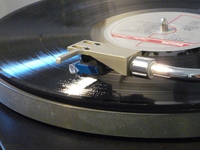
Mozart's Antimony
Medical bedside cabinet, gramophone player with a hypodermic needle substitution, Mozart’s Sonata in C, KV 279 and Sonata in D, KV 576. The needle is slowly scratching irreparable grooves into the record whilst the record in return, is making the needle blunt.. "On 20 October 1791, Mozart told his wife Constanza that he was being poisoned. On 20 November he developed a fever; his hands, feet and stomach became swollen, and he had attacks of vomiting. He died on the 5th of December. Although Antonio Salieri confessed to Mozart’s murder several years later, it is highly unlikely as Salieri suffered from senile dementia. In 1991, Ian James of London’s Royal Free Hospital attributed Mozart’s death to antimony, a poison that Mozart may have been given by his doctor - not to kill him but to cure him. Antimony was prescribed for what was then diagnosed as melancholia. In small doses it leads to headaches, fainting and depression. In large doses it can be fatal within days (Emsley 1999: 225). In the autumn of 1791, Mozart, suffering from severe depression, exacerbated by debt, the ill reception of his new work La Clemenza di Tito, and a commission to write a requiem which he believed was for his own funeral, dosed himself with a variety of medicines – one of these being antimony – and what was meant to cure, killed" (Liebenberg 2011: 85 - 91). -

"I have scars on my hands from touching certain people"
"The words of Seymour Glass, eldest sibling of the Glass family – a lesser known creation of J.D. Salinger’s literary world. The story of this family of child geniuses, who appeared on a 1927 radio quiz show called 'It’s a Wise Child', is chronicled in three of his books – mostly centering on the relationship between the two eldest brothers, Buddy and Seymour. Salinger favours Seymour. He was the most brilliant and idiosyncratic of all the children and unfortunately, for the most part, only present as a memory – since he committed suicide, age 31. Buddy reminisces about one specific Seymour moment: His mother urging him to see a psychiatrist and him telling her that he doesn’t need a head doctor – he needs a hand doctor or a dermatologist, whereupon he looks at his hands and tells her he has these scars – these discolourations on them – from touching certain people. Certain heads, certain colours and textures of human hair leave permanent marks on him. When he put his hand on his little sister Franny’s head when she was still in the carriage, it left a mark. Or with her twin brother, Zooey, when he was six or seven, during a spooky movie. He put his hand on Zooey’s head when he went under the seat to avoid watching a scary scene. It left a mark. Other things, too. Charlotte, the girl he was in love with, tried to run away from him once and he grabbed her dress. It left a permanent lemon-yellow mark on the palm of his right-hand (Salinger 1964:59). His hands were filled with these discolourations – these physical manifestations of his emotions. They became a type of medical condition. And he needed to cure it" (Liebenberg 2011: 91 - 93). Salinger recounts the day of Seymour's suicide in a short story he later wrote, called 'A Perfect Day for Bananafish'. -

Neck-support
"Made from oak, the object was used to support the neck of an individual during post-mortem examinations conducted at the University of Cape Town’s mortuary unit. My first encounter with it was in Dr Yeats’s office in the Pathology Learning Centre, many years ago. Heavy in weight and invested with the traces of hundreds of individuals, it somehow seemed more representative of disease, than the 3500 specimens floating in formaldehyde displayed in the surrounding rooms " ( Liebenberg 2021: 257). -
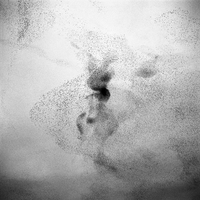
Murmeration
Heart murmurs are sounds – such as whooshing or swishing – made by turbulent blood in or near the heart. When doctors listen to a child's heart, what they usually hear is a simple rhythm: "lub-dub, lub-dub, lub-dub..." Sometimes, they'll hear an extra sound in between the lub and the dub. That extra sound is called a heart murmur. Heart murmurs can be harmless or abnormal. In the case of the latter, it is usually the result of abnormal blood flow through the heart caused by a heart valve not working properly. -

Holes
A virus attacks a cell by attaching itself to the outer wall. It then uses a specialized protein to digest a small hole in the wall of the cell and inject its nucleic acid molecule into the cell's cytoplasm. -
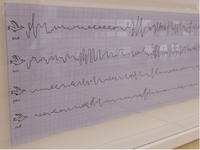
Flight
A chorus of juvenile heartbeats affected by Atrial Septal (ASD) and Ventricular Septal Defects (VSD), Patent Ductus Arteriosus(PDA), and Aortic Valve Stenosis (AVS), transposed to a higher frequency to simulate birdsong -
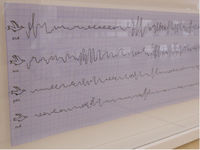
The Lost Boys
After they left Neverland, Mr and Mrs Darling adopted the Lost Boys. Before they had attended school a week they saw what goats they had been not to remain on the island; but it was too late, and they settled down to being as ordinary as “you or me or Jenkins minor” (Barrie 1989: 180). It is sad to say that the power to fly gradually left them. “At first Nana tied their feet to the bedposts so that they should not fly away in the night; and one of their diversions by day was to pretend to fall off buses; but by and by they ceased to tug at their bonds in bed, and they found that they hurt themselves when they let go of the bus. In time they could not even fly after their hats. Want of practice, they called it; but what it really meant was they no longer believed” ( Barrie 1989: 180-181). -
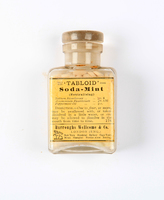
Soda-Mint (Neutralising)
"Antacid, exhilarant and stimulant. From one to three as a neutralising agent, in irritable and acid conditions of the stomach, dyspepsia, flatulence, etc. They may be swallowed with water, or be powdered and dissolved in water and taken as a draught" (BWC 1925:138). -
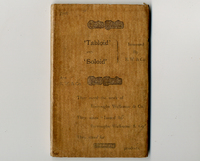
'Tabloid' A Brief Medical Guide (Back cover)
A guide to illnesses common to tropical regions and how to cure them using Burroughs Wellcome & Co.'s products -

'Tabloid' A Brief Medical Guide (End pages)
A guide to illnesses common to tropical regions and how to cure them using Burroughs Wellcome & Co.'s products -

'Tabloid' A Brief Medical Guide (p148)
A guide to illnesses common to tropical regions and how to cure them using Burroughs Wellcome & Co.'s products -

'Tabloid' A Brief Medical Guide (p146,147)
A guide to illnesses common to tropical regions and how to cure them using Burroughs Wellcome & Co.'s products -
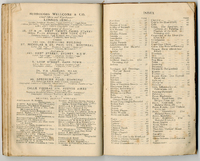
'Tabloid' A Brief Medical Guide (p144,145)
A guide to illnesses common to tropical regions and how to cure them using Burroughs Wellcome & Co.'s products -
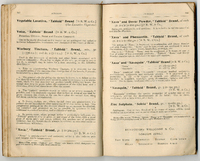
'Tabloid' A Brief Medical Guide (p142,143)
A guide to illnesses common to tropical regions and how to cure them using Burroughs Wellcome & Co.'s products -

'Tabloid' A Brief Medical Guide (p140,141)
A guide to illnesses common to tropical regions and how to cure them using Burroughs Wellcome & Co.'s products -

'Tabloid' A Brief Medical Guide (p138,139)
A guide to illnesses common to tropical regions and how to cure them using Burroughs Wellcome & Co.'s products -

'Tabloid' A Brief Medical Guide (p136,137)
A guide to illnesses common to tropical regions and how to cure them using Burroughs Wellcome & Co.'s products -

'Tabloid' A Brief Medical Guide (p134,135)
A guide to illnesses common to tropical regions and how to cure them using Burroughs Wellcome & Co.'s products -

'Tabloid' A Brief Medical Guide (p132,133)
A guide to illnesses common to tropical regions and how to cure them using Burroughs Wellcome & Co.'s products -

'Tabloid' A Brief Medical Guide (p130,131)
A guide to illnesses common to tropical regions and how to cure them using Burroughs Wellcome & Co.'s products -

'Tabloid' A Brief Medical Guide (p128,129)
A guide to illnesses common to tropical regions and how to cure them using Burroughs Wellcome & Co.'s products -

'Tabloid' A Brief Medical Guide (p126,127)
A guide to illnesses common to tropical regions and how to cure them using Burroughs Wellcome & Co.'s products -

'Tabloid' A Brief Medical Guide (p124,125)
A guide to illnesses common to tropical regions and how to cure them using Burroughs Wellcome & Co.'s products -

'Tabloid' A Brief Medical Guide (p122,123)
A guide to illnesses common to tropical regions and how to cure them using Burroughs Wellcome & Co.'s products -

'Tabloid' A Brief Medical Guide (p120,121)
A guide to illnesses common to tropical regions and how to cure them using Burroughs Wellcome & Co.'s products -

'Tabloid' A Brief Medical Guide (p118,119)
A guide to illnesses common to tropical regions and how to cure them using Burroughs Wellcome & Co.'s products -
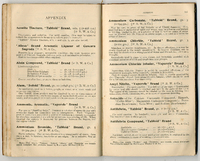
'Tabloid' A Brief Medical Guide (p116,117)
A guide to illnesses common to tropical regions and how to cure them using Burroughs Wellcome & Co.'s products -
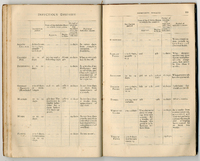
'Tabloid' A Brief Medical Guide (p114,115)
A guide to illnesses common to tropical regions and how to cure them using Burroughs Wellcome & Co.'s products -
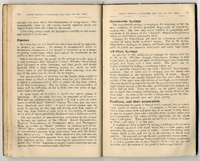
'Tabloid' A Brief Medical Guide (p112,113)
A guide to illnesses common to tropical regions and how to cure them using Burroughs Wellcome & Co.'s products -
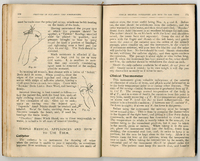
'Tabloid' A Brief Medical Guide (p110,111)
A guide to illnesses common to tropical regions and how to cure them using Burroughs Wellcome & Co.'s products -

'Tabloid' A Brief Medical Guide (p108,109)
A guide to illnesses common to tropical regions and how to cure them using Burroughs Wellcome & Co.'s products -
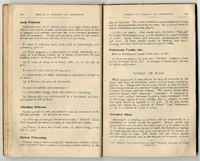
'Tabloid' A Brief Medical Guide (p106,107)
A guide to illnesses common to tropical regions and how to cure them using Burroughs Wellcome & Co.'s products -

'Tabloid' A Brief Medical Guide (p104,105)
A guide to illnesses common to tropical regions and how to cure them using Burroughs Wellcome & Co.'s products -

'Tabloid' A Brief Medical Guide (p102,103)
A guide to illnesses common to tropical regions and how to cure them using Burroughs Wellcome & Co.'s products -

'Tabloid' A Brief Medical Guide (p100,101)
A guide to illnesses common to tropical regions and how to cure them using Burroughs Wellcome & Co.'s products -

'Tabloid' A Brief Medical Guide (p98,99)
A guide to illnesses common to tropical regions and how to cure them using Burroughs Wellcome & Co.'s products -

'Tabloid' A Brief Medical Guide (p96,97)
A guide to illnesses common to tropical regions and how to cure them using Burroughs Wellcome & Co.'s products -

'Tabloid' A Brief Medical Guide (p94,95)
A guide to illnesses common to tropical regions and how to cure them using Burroughs Wellcome & Co.'s products


